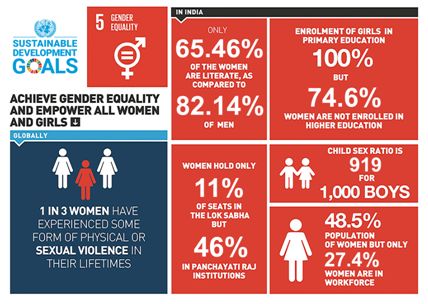- Filter By :
- Polity & Governance
- International Relations
- Social Justice
-
Q. Objectives of gender justice go beyond the boundaries of the courts. Comment. (250 words)
19 Nov, 2019 GS Paper 2 Social JusticeApproach
- Write about the objectives of gender justice.
- Mention about steps taken by the judiciary to achieve gender justice.
- Mention the limitations of judicial interventions and the need of reforms at the grassroots level for social transformation.
Introduction
- Gender justice seeks to achieve a life of dignity and freedom to women as a basic human right. It includes sharing of power and responsibility between women and men at home, in the workplace, and in the wider national and international communities.
- Gender justice is indispensable for development, poverty reduction, and is crucial to achieving human progress.
Body
Provisions for gender justice
- The Constitution of India (Article 14, 19 and 21) guarantees the right of equality and freedom from sexual discrimination to Indian women.
- India is also signatory to the Convention for the Elimination of All Forms of Discrimination Against Women, or CEDAW.
Gender discrimination and injustice in India
India was ranked 108th in the Global Gender Gap Index 2018. Mentioned below are some facts about gender discrimination in India:
Role of judiciary towards achieving gender justice
- Addressing sexual harassment at workplace: Supreme Court in a landmark judgement in the Vishakha and others v State of Rajasthan 1997 case gave ‘Vishakha guidelines’ which formed the basis for the The Sexual Harassment of Women at Workplace (Prevention, Prohibition and Redressal) Act, 2013 ("Sexual Harassment Act").
- Voluntary Health Association of Punjab vs. Union of India, 2013: Supreme Court issued guidelines for the effective implementation of Pre-conception and Pre-natal Diagnostic Techniques (Prohibition of Sex Selection) Act, 1994.
- Shayara Bano v. Union of India & Others. 2017: Supreme Court in a 3:2 majority judgement, held the practice of triple talaq as unconstitutional.
- Recently, Supreme Court clubbed and referred four cases of contentious religious practices to a larger 7-judge bench. Those are:
- Entry of women into the Sabarimala temple
- Muslim women’s entry into mosques
- Female genital mutilation among Dawoodi Bohras
- Entry of Parsi women married to non-Parsis in the Agyari
Limitations of judicial interventions
- Conflict between constitutional morality and customary morality: The ‘doctrine of essentiality’ allows courts taking upon themselves the responsibility of determining the essential and non-essential practices of a religion, which often creates a clash with religious beliefs and faith.
- Addressing contentious issues may lead to judicial overreach: For ex: Supreme Court had to modify its directions regarding formation of Family Welfare Committees, given in Rajesh Sharma v/s State of U.P, 2017 arguing that they are an extra-judicial authority, which cannot exercise powers and functions of police and court. [Section 498-IPC Anti dowry law]
- Opening up of Pandora’s Box: Judicial intervention in select cases would raise a demand for similar interventions against a number of unethical but permissive religious practices.
- Enforceability of judicial orders: It becomes difficult to enforce the judicial orders in matters of faith and religion which are not aligned with public sentiments, as seen in the Sabrimala temple issue.
- Inequality in judiciary: There are only three sitting women judges (8.8%) out of the total sanctioned strength of the apex court, 34. Hence, it has been alleged that the higher judiciary itself is not representative.
Way Forward
- Need for social transformation: There is a need to remove the rigidities in traditions and beliefs which can be achieved only at societal level through awareness and education.
- There is an urgent need to address the problems of lack of education, development deficit, poverty, improper enforcement of the laws, lack of awareness among women, deep rooted patriarchy, etc. to achieve the goal of gender justice in India.
- Government interventions in the form of Sukanya Samridhi Yojana, Beti Bachao Beti Padhao are steps in the right direction which could lead to a dignified life to every woman in the country.
To get PDF version, Please click on "Print PDF" button.
Print PDF





